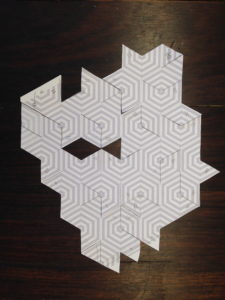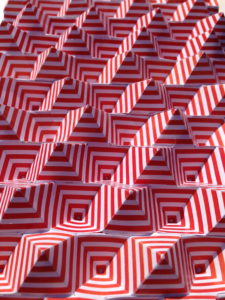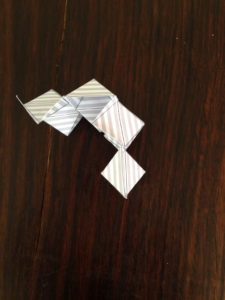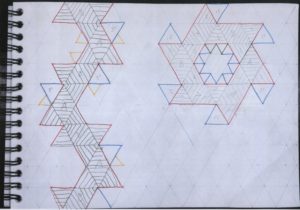- LOADING...
-
Exhibition:2014, Zig-Zag project, White Gallery, Osik


Complex project for the White Gallery in Osik based on the third discovered zig zag ornament.
curator Ondřej Chrobák
The starting point for the exhibition was the location of the gallery and its disposition. I used the ornament that I invented during the realisation of the Zig Zag mural for the DOX in Prague. Here it is a third type of the ornament, which has a dual reading depending on the view angle of the viewer. I used the first two ornaments at the DOX. In this third he frontal view and the view from angle differ most. From an angle we see primarily striped zigzag lines and between them diagonally striped squares. From the front view, we see regular concentric squares parallel with the edge of the format. Because the squares are clearly defined, the viewer even after the experience with a side view must make an effort to be able to see also from the front view the zigzag stripes, which is easier with the two previous ornaments.
I had an intention to create a relief based on this ornament. It is formed by rising and buried pyramids painted with stripes so that their front would match the source squares. Then I wanted to convert this relief in perspective, but in a plane into a painting. To be able to achieve such a task, I decided to make a paper model, photograph it and use the photo as an aid for painting. During the drawing of the patterns for the design and gluing the relief, I realised that some designs were becoming a peculiar, sometimes ornamental solution of the surface. Experimenting with designs and subsequent spatial compositions began to bring me new unexpected possibilities and discoveries. I moved the theme of Zig Zag not only into space but also back to the surface. In one experiment, when I managed to solve rolling over and joining the relief surface by ninety degrees, I put this paper model into the prepared model of the gallery and the “shem” fitted in. The paper model became the model for the aluminium sculpture filling one of the corners of the glass gallery. The paper reliefs along with the new paintings from the series “Zig Zag III” flipped the exhibition to a yet another reading. I created the original planar ornament in the lawn area around the gallery using the lawn mower.
Ondřej Chrobák review
Petr Kvíčala belongs to the generation wave that in the late nineteen eighties and early nineties dramatically expanded and transformed the semantic and formal ground plan of Czech art. The contemporary theories described the new situation as a postmodern turn. Petr Kvíčala’s position, however, was and still remains in relation to the current trends synchronous, but parallel at the same time. Mutual intersections are mostly generated by continuous, for some perhaps stubborn developing and solving of a personal theme. Although it progresses in time, certain elements and principles, such as repetition, geometry (in a “soft” freehand-designed variant), or a process approach to painting steadily return. As a side, but an eye-catching effect arose an instant recognisability of his works. Not only visual, but also conceptual. Kvíčala systematically returns in the game concepts that have been in the context of modern art traditionally understood more or entirely negatively: ornament, decor, banality, or emptiness. In this sense, it is possible to declare Kvíčala’s pictures a record of an intellectual adventure, moving in the territory where the slightest mistake or misstep have literally disastrous consequences. The link that goes across and through the current exhibition at the White Gallery is the original zigzag ornament developed by Petr Kvíčala. It took control over the lawn around the gallery, the surface of a large format object, as well as the surface of the paintings and drawings. Kvíčala first experimented with this type of ornament in the realisation of the large-format Zig Zag mural for the DOX in Prague in 2011. The ornamental pattern has two ways of “reading” depending on the view angle. The concentric squares parallel to the edge of the format visible from the frontal view change from the angle into striped zigzag lines and striped squares diagonally placed between them.
The name White Gallery immediately associates the English term “white cube”. The white cube, both visually and semantically neutral environment, was in the modernist understanding considered the ideal environment for the presentation of art. If there is something the White Gallery is not, it is certainly this type of exhibition space. The centre of the gallery consists of a technologically sophisticatedly designed depository, in which is stored the artistic estate of the artist Ludmila Jandová, the mother of the gallerist. Also the gallery’s location on a meadow in the middle of a bucolic idyll fundamentally determines the expectations and tuning of its visitors. Petr Kvíčala decided to respond particularly to this unique constellation. He conceived the exhibition not as a simple sum of exposed artefacts, but as a complex installation, where particularities assemble along with the interior and exterior of the gallery in one whole. In this case, the exhibition becomes an autonomous artistic medium.
Text Ondřeje Chrobáka
Petr Kvíčala patří ke generační vlně, která na přelomu osmdesátých a devadesátých let razantně rozšířila a proměnila významový i formální půdorys českého umění. Dobová teorie novou situaci popisovala jako postmoderní obrat. Pozice Petra Kvíčaly však byla a stále zůstává k aktuálním tendencím sice synchronní, ale paralelní zároveň. Průniky jsou generovány především kontinuálním, pro někoho možná umanutým, rozvíjením a řešením osobního tématu. To se v čase sice posouvá, ale určité elementy a principy jako opakování, geometrie (v „měkké“ od ruky konstruované variantě) nebo procesuální přístup k malbě se vytrvale vracejí. Jako vedlejší, ale nepřehlednutelný efekt vyvstala okamžitá rozpoznatelnost jeho prací. Nikoli pouze vizuální, ale rovněž konceptuální. Kvíčala systematicky vrací do hry pojmy, které byly v kontextu moderního umění tradičně chápány spíše či zcela negativně: ornament, dekor, banálnost nebo vyprázdněnost. Kvíčalovy obrazy je možné v tomto smyslu prohlásit za záznam intelektuálního dobrodružství, pohybu na území, kde sebemenší chyba nebo přešlap mají doslova katastrofální důsledky.
Spojujícím článek, který prochází napříč a skrz aktuální výstavu ve White Gallery, je Petrem Kvíčalou vyvinutý, originální cikcak ornament. Opanoval trávník kolem galerie, povrch velkoformátového objektu i plochy obrazů a kreseb. Kvíčala poprvé experimentoval s tímto typem ornamentu při realizaci velkoformátové nástěnné Zig Zag malby pro pražský DOX v roce 2011. Ornamentální vzor má dvojí způsob „čtení“, který závisí od úhlu pohledu. Soustředné čtverce paralelní s hranou formátu patrné při frontálním pohledu, se z úhlu mění v puhované cikcak linie a mezi nimi pruhované čtverce postavené nakoso.
Název White Gallery okamžitě asociuje anglický termín „white cube“. Bíla kostka, vizuláně i významově neutrální prostředí, byla v modernistickém chápání považována za ideální prostředí k prezentaci umění. Jestli něčím White Gallery není, tak rozhodně tímto typem výstavního prostoru. Střed galerie tvoří technologicky rafinovaně řešený depozitář, v němž je uchovávána umělecká pozůstalost malířky Ludmily Jandové, matky galeristy. Rovněž lokace galerie na louce uprostřed bukolické idyly zásadním způsobem determinuje očekávání a naladění jejich návštěvníků. Petr Kvíčala se rozhodl reagovat právě na tuto unikátní konstalaci. Výstavu koncipoval nikoli jako prostý součet vystavených artefaktů, ale jako komplexní instalaci, kde se jednotlivosti skládají spolu s interiérem i exteriérem galerie v jeden celek. Výstava se v tomto případě stává autonomním uměleckým médiem.
reviews:
Ondřej Chrobák, Petr Kvíčala ZIG ZAG, 2014
Silvia Šeborová, “Zig Zag Kvíčala”, Artalk, http://artalk.cz/2014/09/03/zig-zag-kvicala/
Kamil Nábělek, “Petr Kvíčala, Zig Zag”, Art&Antique č.9, str. 78-79, Praha, 2014
